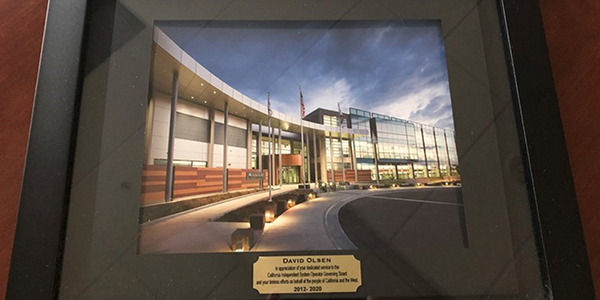The CAISO Board of Governors praised the work of retiring colleague David Olsen on Wednesday and adopted the second part of a plan to speed the interconnection of storage resources to avoid future blackouts.
The governors and new CEO Elliot Mainzer recognized former Chair Olsen for his efforts to bring renewable power into the mainstream over the past four decades, including nearly nine years on the CAISO board.
“You are truly a titan in the energy field,” Chair Angelina Galiteva said. “Your wisdom, dedication and commitment to the decarbonization of the grid … especially to elevating the ISO to an international and global leader in the field of integrating renewables … is greatly appreciated and cherished.”
Mainzer read a resolution from the governors honoring Olsen and presented him, in an online meeting, with a commemorative plaque. The resolution recognized Olsen’s many achievements, including ushering in an era of corporate sustainability as president of Patagonia in the late-1990s. He led the outdoor-gear company’s carbon-reduction efforts, making it the first U.S. corporation to get its electricity from wind and solar power. (See Ex-CAISO Board Chair to Retire.)
Olsen, 74, served as CAISO board chair from February 2018 to Oct. 1. Earlier this month, he announced he would retire Nov. 30 with more than a year left in his term.
“I’ll be 75 years old soon and have been on the CAISO board for almost nine years,” Olsen said in an email. “That’s long enough on both fronts.”
Hybrid Resources Initiative
The board unanimously approved the second phase of CAISO’s hybrid resources initiative, letting co-located storage and generation resources operate under a single resource ID.
“The hybrid model allows for the underlying resources to be managed by the resource operator as opposed to the ISO,” CAISO COO Mark Rothleder said in a memo to the board. New provisions would allow hybrid resources to provide energy and ancillary services, he said.
“The proposal also includes a dynamic limit tool that will enable the resource operators to communicate their maximum and minimum operating limits to the ISO in real time,” Rothleder wrote. “This tool will help the ISO ensure it is issuing feasible dispatches to hybrid resources participating in the market.”
The board approved the first phase of the hybrid resources initiative in July. It laid out new rules for co-located resources that operate under separate resource IDs for dispatch purposes. FERC approved those Tariff changes Thursday, allowing them to take effect in December. (See related story, FERC Accepts CAISO Co-Located Resources Plan.) The ISO’s second-phase proposal also requires FERC approval.
Both phases are intended to better integrate storage coupled with solar and wind generation. CAISO needs thousands of megawatts of storage to transition to 100% clean energy by 2045, as state law requires. It has about 200 MW of storage now.
In the near term, the ISO is urgently trying to interconnect more storage before summer 2021. Resource shortfalls next summer are forecasted to exceed those in August and September, when CAISO declared energy emergencies, including rolling blackouts, in mid-August.




